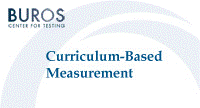Buros-Nebraska Series on Measurement and Testing

Curriculum-Based Measurement
Date of this Version
1993
Document Type
Article
Citation
Curriculum-Based Measurement, edited by Jack J. Kramer (Lincoln, NE: Buros Institute of Mental Measurements, 1993).
Abstract
Curriculum-based measurement (CBM) is a form of curriculum-based assessment. As such, CBM has three features in common with all curriculum-based assessment approaches (Tucker, 1987): Test stimuli are drawn from the student's curriculum; assessment is ongoing and repeated across time; and assessment data are used to formulate instructional decisions.
Despite these similarities to other forms of curriculum-based assessment, CBM is distinctive because of two important features: It measures student proficiency across the annual curriculum and relics on standardized, prescriptive measurement methods (Fuchs & Dena, in press). The first purpose of this chapter is to explain these two features of CBM, by contrasting the CBM model to the predominant, mastery measurement form of curriculum-based assessment.
The second objective of this paper is to demonstrate how CBM databases can be used to help formulate instructional decisions. Within this context, research investigating the efficacy of each instructional use is reviewed.
As indicated above, two important features of curriculum-based measurement (CBM) are (a) its focus on measuring student proficiency across the annual curriculum and (b) its use of a standardized, prescriptive measurement methodology, with demonstrated psychometric acceptability. To explain each of these features, I contrast CBM to the more common, predominant form of curriculum-based assessment known as mastery measurement. Within this section, I first explain and provide an example of mastery measurement. Then, I explain CBM and provide an example. Finally, the salient differences between mastery measurement and CBM are explored.
Mastery Measurement
Mastery measurement is the most common form of curriculum-based assessment (see Shinn, Rosenfield, & Knu tson, 1989 for discussion of different types of curriculum-based assessment). Mastery measurement describes student mastery of a series of short-term instructional objectives or instructional levels (see Blankenship, 1985 and Gickling & Thompson, 1985 for explanation of these forms of mastery measurement). So, for example, let us say that Mrs. P. wants Dolly to master the fourth-grade computation curriculum. That is, by June Mrs. P. wants Dolly to compute accurately all problem types encompassed within the fourth-grade curriculum. In designing a mastery measurement system, Mrs. P. would begin by completing two large tasks. She would (a) determine a sensible instructional sequence for the fourth-grade computation curriculum and (b) design a criterion referenced testing procedure to match each step in that instructional sequence.
Let us say, for example, that after careful inspection of the fourthgrade computation curriculum, Mrs. P. identified the skills listed in Table 1. These are the universe of problem types incorporated within her fourth-grade curriculum. She further determined that a logical sequence of skills for instruction were the following: multidigit addition with regrouping, multidigit subtraction with regrouping, multiplication facts (factors to 9), division facts (divisors 6-9), multiplying two 2-digit numbers without regrouping, multiplying 1- or 2-digit numbers with regrouping,dividing3-byl-digitnumberswithoutremainders,dividing 2- or 3- by 1-digit numbers with remainders, adding and subtracting mixed decimals to hundredths, and adding and subtracting simple or mixed fractions without regrouping.
Included in
Curriculum and Instruction Commons, Educational Assessment, Evaluation, and Research Commons


Comments
Copyright © 1993 by Buros Institute of Mental Measurements. Digital Edition Copyright © 2012 Buros Center for Testing. This book may be downloaded, saved, and printed by an individual for their own use. No part of this book may be re-published, re-posted, or redistributed without written permission of the holder of copyright.